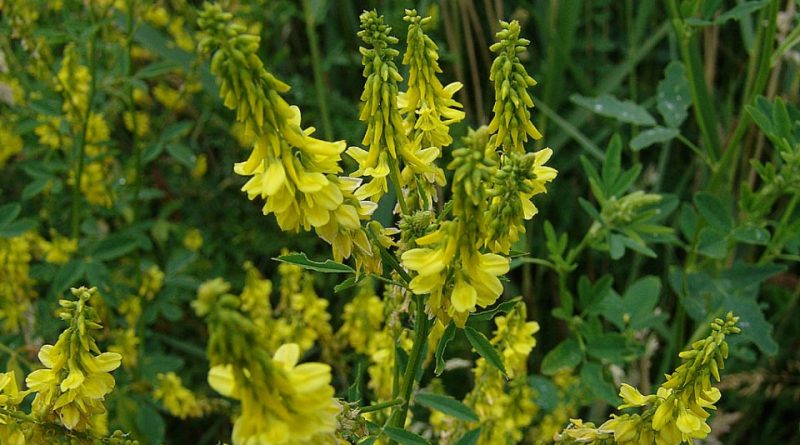Melilotus officinalis
Melilotus officinalis
The sweet yellow clover or yellow melilot or ribbed melilot or common melilot, (Melilotus officinalis (L.) Pall.) is a herbaceous species belonging to the Fabaceae family.
Systematics –
From a systematic point of view it belongs to the Eukaryota Domain, Kingdom Plantae, Magnoliophyta Division, Magnoliopsida Class, Fabales Order, Fabaceae Family, Subfamily Faboideae, Tribe Trifolieae and therefore to the Genus Melilotus and to the Species M. officinalis.
The term Trigonella officinalis (L.) Coulot & Rabaute is synonymous.
Etymology –
The term Melilotus comes from mél, mellis honey and from lotus a sort of clover: sweet clover. The specific epithet officinalis derives from offícina, medieval laboratory: for the qualities of the plant to be used in pharmaceuticals, herbal medicine, liquor, perfumery and the like.
Geographic Distribution and Habitat –
Melilotus officinalis is a plant with Eurasian origins in the strict sense, that is from Europe to Japan and today widespread in almost all areas of the world, but with some important gaps relating to continental or climatic areas.
Description –
The sweet yellow clover is a species, annual or biennial, herbaceous with caule erect with alternate trifoliate leaves and yellow and fragrant flowers. The fruit is a camara (indehiscent legume) of the dimensions of 3-5 x 2-4 mm, pendula and apicolata, ovoid with acute apex and beak, glabrous and light brown when ripe, with cross-linked transverse ribs, which contains 1-2 seeds 1,3-1,6 x 1-1,3 mm, ovoid, opaque, smooth, greenish or brownish-yellowish.
Cultivation –
The sweet yellow clover is grown not only for medicinal purposes, but also for the production of fodder for animals, and for being buried in order to improve soil composition. It is also used for the production of a delicate and aromatic mono floral honey. The melilot is sown at the beginning of spring or even at the end of winter. You can sow directly at home, with a planting distance of at least 20 cm, as the plants will tend to develop in the form of a small bush during flowering. Germinates generally after 10-15 days. For the cultivation technique, the following sheet can be consulted.
Uses and Traditions –
Sweet yellow clover is a forage plant; when storage, however, is not carried out in optimal conditions, it can give rise to the livestock that feeds it, due to the deterioration of the plant, to haemorrhages that can also be fatal.
This plant contains in the flowery portion toxins with an anticoagulant action such as melitotoxin, coumarigenin and coumarin. By ingestion of this excess plant you can have damage, which consists of a lengthening of the time of hemocoagulation.
Its introduction into the therapeutic as antispasmodic is due to Galen.
The history of the introduction of coumarin in therapy is of considerable interest: it began with the observation of a hemorrhagic syndrome in the cattle that had ingested clover and battered melilot. This syndrome was associated with a decrease in plasma prothrombin levels. In 1941, Link of the University of Wisconsin demonstrated that this hemorrhagic disease in cattle was caused by a coumarin-like compound. Link synthesized the dihydroxy-coumarin (dicumarol) which was the precursor of the anticoagulants of the dicumarol and indandionic type.
For therapeutic uses its flowers are used and the eye drops produced thanks to the decoction or to the infusion is indicated for conjunctival inflammations and for the stye.
The distilled water of Meliloto is a refreshing, softening and soothing lotion particularly suitable for dry and tired skin.
The main constituents are: 0.4-1% of coumarin, flavonoids (derivatives of kaempferol and quercetin), sapogenins, tannins. The main activities are: antispasmodic, digestive; sedative, astringent; anti-edema. Therapeutic use: venolymphatic insufficiency; digestive disorders of nervous origin; minor sleep disorders.
Because of these peculiarities it is indicated in the treatment of inflammatory or stasis edema, in the symptomatic treatment of functional disorders of cutaneous capillary fragility.
For the antispasmodic action (coumarin) is indicated in minor digestive disorders and mild forms of insomnia.
The main therapeutic indications are, however, the disorders of the venous circulation, such as hemorrhoids, varices, and also leg ulcers, thrombophlebitis, prophylaxis of thrombosis, lymphatic stasis.
Melilotus officinalis is a very mellifera plant and a good honey is obtained, even unifloral, even if not very frequent; it is however an important source of nectar for bees.
Preparation Mode –
Folk medicine uses the infusion of sweet yellow clover, with an extremely pleasant and aromatic taste, in headaches, as a digestive (after meals) as an antispasmodic and also in the insomnia of children and the elderly, thus attributing to the plant activities similar to those of Chamomile. In addition, melilot also has diuretic properties (5% infusion).
Tablets soaked in a decoction of melilot, or creams or ointments at 10-20%, can be applied on the painful joints (rheumatism) where they show antalgic action.
Guido Bissanti
Sources
– Acta Plantarum – Flora of the Italian Regions.
– Wikipedia, the free encyclopedia.
– Treben M., 2000. Health from the Pharmacy of the Lord, Advice and experience with medicinal herbs, Ennsthaler Publisher
– Pignatti S., 1982. Flora of Italy, Edagricole, Bologna.
– Conti F., Abbate G., Alessandrini A., Blasi C. (edited by), 2005. An annotated checklist of the Italian vascular flora, Palombi Editore.
Attention: Pharmaceutical applications and alimurgical uses are indicated for informational purposes only, they do not in any way represent a medical prescription; there is therefore no liability for their use for curative, aesthetic or food purposes.


